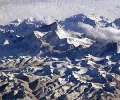
A View of Pollution from the Top
Study shows pollutant levels in soil collected from Mount Everest glacier were acceptable for most trace elements; arsenic and cadmium exceeded drinking water standards.
Nearly one-fifth of the earth’s surface is comprised of mountains that play a role in the storage and distribution of fresh water, with one-tenth of the world’s population relying on that mountain snowpack as their sole source of fresh water.
Understanding the amount of pollutants in soil and snow is critical to maintaining the quality of alpine water sources, and is the subject of a study published in the Fall 2010 issue of Soil Survey Horizons, published by the Soil Science Society of America.
Researchers at the University of Southern Maine collected soil samples from Mount Everest’s Rongbuk glacier and snow samples were taken from the northeast ridge of the mountain. The samples were then analyzed for trace element concentrations, including cadmium, nickel, zinc, chromium, cobalt, arsenic, copper, manganese, mercury, vanadium, and magnesium.
The results of the study show that most trace elements were at acceptable levels. The amounts arsenic and cadmium in the snow samples, however, exceeded the U.S. Environmental Protection Agency’s drinking water standards, and the amount of arsenic in the soil samples was above the EPA’s screening guidelines.
Arsenic is associated with bladder, skin, and kidney cancer, while cadmium is linked to lung and prostate cancer through the ingestion of contaminated food and water. Both are the by-products of fossil fuel combustion.
Bill Yeo, who authored the study, suggests the levels are a result of the surrounding region’s rapid increase in industrialization. According to Yeo’s research, Asia is the leading contributor of atmospheric pollutants.
Other studies on neighboring mountains have revealed similar findings indicating the potential for multiple water sources to become contaminated. For this study, Mount Everest was selected because of its altitude and remoteness. Other research has been performed at comparable sites in Europe, Japan, Alaska, and New Zealand. Studies in Antarctica found concentrations three to four times lower than in Yeo’s analysis, illustrating that the amount of arsenic and cadmium on Everest came from human contributions.
This article is available for free access at
Soil Survey Horizons website until the next quarterly issue.
Soil Survey Horizons is a medium for expressing ideas, problems, and philosophies concerning the study of soils in the field. The Soil Science Society of America is a progressive, international scientific society that fosters the transfer of knowledge and practices to sustain global soils. Based in Madison, Wis, and founded in 1936, SSSA is the professional home for more than 6,000 members dedicated to advancing the field of soil science.